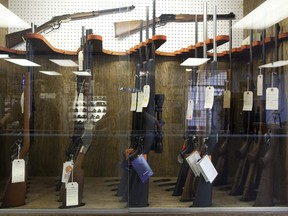‘The way the regulation was drafted, it was rushed through as an order-in-council and done in such a poor manner, it’ll cause issues for the buyback down the road’

OTTAWA – The organization tasked with helping retailers navigate the Trudeau Liberals’ mandatory gun “buyback” says the government has bit off far more than it can chew and is now discovering the difficulty with the sheer volume of items it may have to expropriate.
Wes Winkel, president of the Canadian Sporting Arms and Ammunition Association (CSAAA,) said the government apparently didn’t anticipate that its ban on “assault-style” firearms involved a massive number of parts and accessories that could be captured by the buyback’s planned expropriation, which will require gun owners and retailers holding inventory of those items to be compensated.
That’s because “assault-style” guns are often built by retailers, and owners, using any number of hundreds of different components.
“It’s so easy to say ‘this is illegal and we’ll buy it back,’ but they took a category of firearms which is so modular in nature,” Winkel said. Different parts can be fastened to different weapons that then fall into the assault-style category, in other words. “It’s a bit like the ‘Mr. Potato Head’ of guns,” he said.
“So many of these things are in different facets of being built at the (retailer) level; most were not sold complete. They’re sold in component form — some of the components themselves are prohibited, some are not. Some of them only fit (prohibited) categories of firearms, some of them fit other categories,” Winkel said.
The amnesty on banned guns is set to expire at the end of October 2025, presuming a buyback regime is in place by then to provide owners and retailers compensation for their seized weapons. But Winkel expects the process is turning out to be much more complicated and much more expensive than the federal government anticipated.
“They don’t understand that liaising with industry should have happened before the regulations were drafted,” he said.
“A lot of our (members’) businesses are not firearms-specific — like Cabela’s (and) Canadian Tire — so the people that work there aren’t necessarily sure what firearms are covered by (the confiscation) and which ones are not,” Winkel explained.
“That’s where we come in, where we assist them in the procedures and say ‘yes, these 10 firearms are prohibited but only these seven are covered by the buyback.’”
He said that if the government doesn’t have a buyback in place by October 2025 when the amnesty is set to expire, businesses holding now-banned inventory will be stuck in a legal grey zone.
“Once that amnesty expires, if we don’t deal with this inventory, then we can no longer get import permits and conduct our business in a regular fashion,” he said.
“The costs have ballooned on the administration side,” Winkel said. “They’ve used up so much budget already, and they still haven’t bought anything.”
Complicating matters further is that many of the firearms covered for compensation are in various levels of completion, ranging from complete, ready-to-fire firearms to parts kits.
“We’ve said, ‘you can’t just buy assembled firearms … these businesses (are the ones that) put them together.”
Winkel said the CSAAA has helped identify and price over 3,500 separate parts and components that should be eligible for compensation.
While Winkle is prohibited from discussing all the specifics of his work with government due to a non-disclosure agreement, he said the program has been painful to be a part of.
“The bureaucracy is just growing and growing,” he said.
“When we started we had meetings every Monday (on) the progress of the program. Typically it’s one or two people from our organization, and now, at times, there’s as many as 30 or 35 bureaucrats from the federal government on those conference calls.”
He said the new rules have already shuttered dozens of retailers across Canada.
His association tried from the very beginning to warn the public safety ministry, at the time run by cabinet minister Bill Blair, about how difficult the buyback would be, Winkel said, but he doesn’t think they understood it.
“We sounded the alarm bells right off the bat, which is why we got involved,” he said.
“We said this is not a simple process, it’s very complicated — and of course now they’ve learned that we were right.”
National Post
Our website is the place for the latest breaking news, exclusive scoops, longreads and provocative commentary. Please bookmark nationalpost.com and sign up for our politics newsletter, First Reading, here.